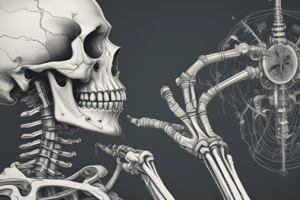Podcast
Questions and Answers
What happens when the biceps muscle contracts?
What happens when the biceps muscle contracts?
- The radius moves downward
- Both the biceps and triceps contract
- The arm straightens
- The arm bends at the elbow joint (correct)
Antagonistic muscles can push against each other.
Antagonistic muscles can push against each other.
False (B)
What role do tendons play in muscle contraction?
What role do tendons play in muscle contraction?
Tendons transmit the pulling force from muscles to bones.
The pair of muscles that work together, pulling in opposite directions, are called __________ muscles.
The pair of muscles that work together, pulling in opposite directions, are called __________ muscles.
Match the following muscles with their actions:
Match the following muscles with their actions:
List three functions of the skeleton.
List three functions of the skeleton.
Which type of joint allows for the most movement?
Which type of joint allows for the most movement?
The elbow joint is a ball-and-socket joint.
The elbow joint is a ball-and-socket joint.
The biceps muscle is attached to the ___ and ___ bones.
The biceps muscle is attached to the ___ and ___ bones.
Match the bones that protect the following organs:
Match the bones that protect the following organs:
How many ribs does a person have?
How many ribs does a person have?
What is the primary role of tendons?
What is the primary role of tendons?
Name the bones that form the hinge joint at your elbow.
Name the bones that form the hinge joint at your elbow.
Flashcards
Function of skeleton
Function of skeleton
The skeleton supports the body, helps it move, and protects internal organs.
Similarities in arm and leg bones
Similarities in arm and leg bones
Arm and leg bones have similar structure, though different shapes that allow for different functions.
Number of ribs
Number of ribs
A person has 12 pairs of ribs, for a total of 24 ribs.
Bones protecting the brain
Bones protecting the brain
Signup and view all the flashcards
Bones protecting the heart and lungs
Bones protecting the heart and lungs
Signup and view all the flashcards
Fixed joints
Fixed joints
Signup and view all the flashcards
Fixed joint location
Fixed joint location
Signup and view all the flashcards
Moveable joints
Moveable joints
Signup and view all the flashcards
Ball and socket joint in shoulder
Ball and socket joint in shoulder
Signup and view all the flashcards
Bones in a ball-and-socket joint
Bones in a ball-and-socket joint
Signup and view all the flashcards
Hinge joint in elbow
Hinge joint in elbow
Signup and view all the flashcards
Bones in a hinge joint
Bones in a hinge joint
Signup and view all the flashcards
Muscle function
Muscle function
Signup and view all the flashcards
Biceps muscle attachment
Biceps muscle attachment
Signup and view all the flashcards
Triceps muscle attachment
Triceps muscle attachment
Signup and view all the flashcards
Meaning of 'bi' and 'tri'
Meaning of 'bi' and 'tri'
Signup and view all the flashcards
Biceps contraction
Biceps contraction
Signup and view all the flashcards
Radius and Scapula
Radius and Scapula
Signup and view all the flashcards
Tendons
Tendons
Signup and view all the flashcards
Antagonistic muscle
Antagonistic muscle
Signup and view all the flashcards
Triceps contraction
Triceps contraction
Signup and view all the flashcards
Muscle relaxation
Muscle relaxation
Signup and view all the flashcards
Arm straightening (muscles)
Arm straightening (muscles)
Signup and view all the flashcards
Muscle's pulling force
Muscle's pulling force
Signup and view all the flashcards
Biceps/Triceps (antagonistic action)
Biceps/Triceps (antagonistic action)
Signup and view all the flashcards
Why tendons shouldn't stretch
Why tendons shouldn't stretch
Signup and view all the flashcards
Biceps alone can't straighten
Biceps alone can't straighten
Signup and view all the flashcards
Study Notes
The Human Skeleton
- The skeleton supports the body and helps it move.
- It protects internal organs.
- The diagram shows the main bones.
Functions of the Skeleton
- Supports the body
- Helps the body move
- Protects internal organs
Bones in the Human Body
- Cranium (protects the brain)
- Vertebral column
- Clavicle
- Scapula
- Sternum
- Ribs
- Humerus
- Ulna
- Radius
- Pelvic girdle
- Carpals
- Femur
- Tibia
- Fibula
Ribs
- A person has 12 pairs of ribs
Bone Protection
- Bones protect internal organs (brain, heart and lungs)
Animal Skeletons
- X-ray of a mink suggests differences in bone structure compared to humans.
Joints
- Joints are where two bones meet.
- Two main types of Joints: Fixed and Moveable joints
- Fixed joints are found in the cranium. The bones are firmly joined to protect the brain.
- The jawbone is an example of a moveable joint.
- Moveable joints allow the bones to move.
- Examples include ball-and-socket joints (shoulder) and hinge joints (elbow).
Hinge Joints
- Move in one direction, like a door on a hinge.
- Example: elbow joint.
Ball-and-Socket Joints
- Move in almost all directions.
- Example: shoulder joint.
Muscles
- Muscles help with movement.
- Tendons connect muscles to bones.
- Tendons are strong and don't stretch.
- Muscles can contract (get shorter).
- Muscles produce a pulling force.
Antagonistic Muscles
- Two muscles working together (biceps and triceps)
- One muscle contracts, the other relaxes.
- This allows for both bending and straightening of the arm
Studying That Suits You
Use AI to generate personalized quizzes and flashcards to suit your learning preferences.




